Artificial Intelligence (AI) and the Future of Service Robots
VerifiedAdded on 2021/06/30
|10
|3251
|302
Report
AI Summary
This report investigates the influence of emerging technologies, particularly Artificial Intelligence (AI) and service robots, on consumer behavior and market dynamics within a global context. It begins by defining AI and its different approaches, then explores how AI works, focusing on machine learning. The report delves into service robots, examining their present volume, market applications, and the key players in the industry, highlighting the technological competition between the US and APAC countries. It analyzes the global impact of service robots, including their positive effects like increased productivity and cost reduction, while also addressing potential threats such as unemployment and the risks associated with data privacy. The report then examines global consumer behavior, discussing how AI will change marketing strategies and customer interactions, including the potential for bias and the evolving role of robots in daily life, using examples like Samsung Bot Handy and Blue Ocean Robotic. The report concludes by assessing the impact of AI service robots on consumer behavior, market trends, and the future of technology.
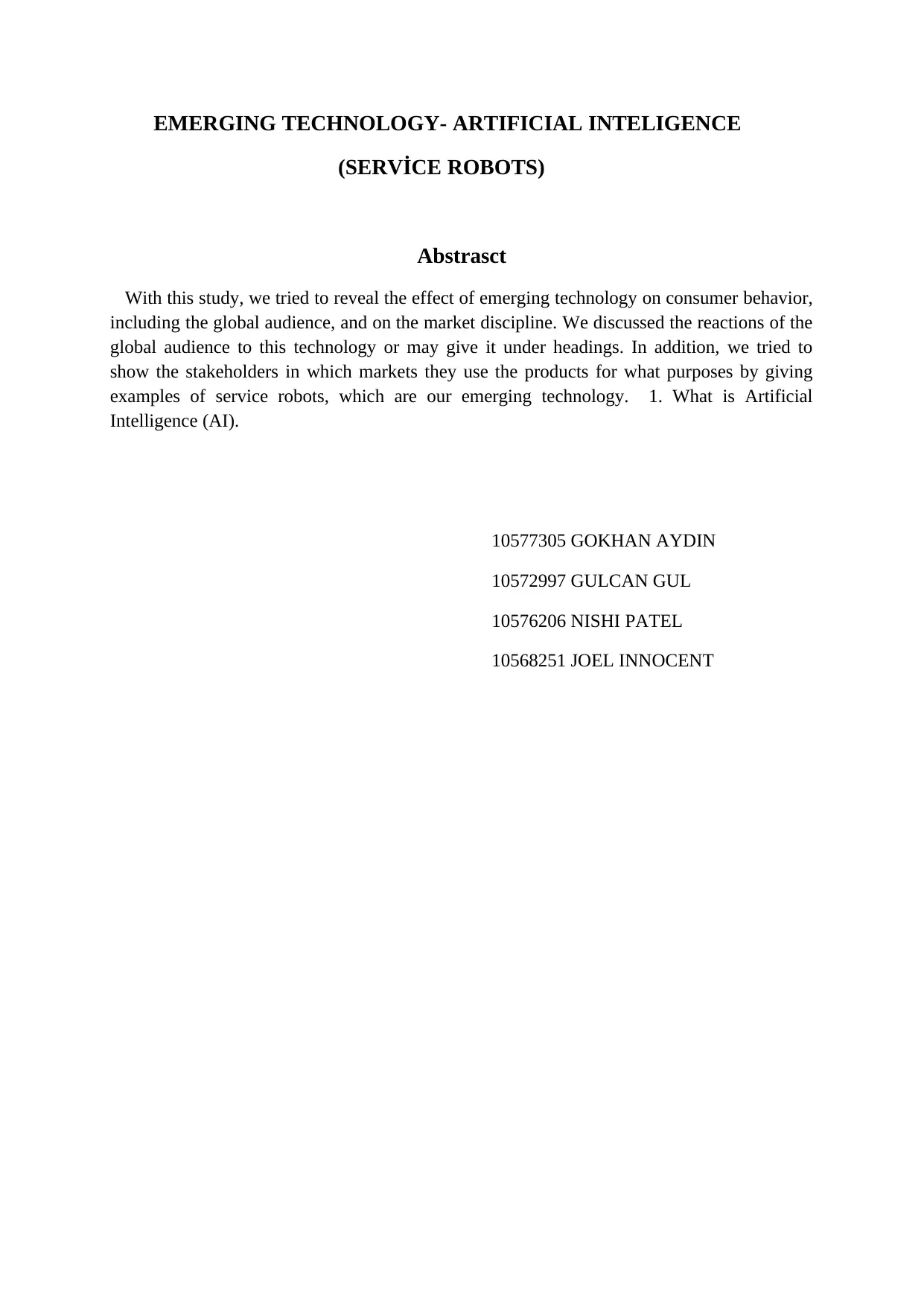
EMERGING TECHNOLOGY- ARTIFICIAL INTELIGENCE
(SERVİCE ROBOTS)
Abstrasct
With this study, we tried to reveal the effect of emerging technology on consumer behavior,
including the global audience, and on the market discipline. We discussed the reactions of the
global audience to this technology or may give it under headings. In addition, we tried to
show the stakeholders in which markets they use the products for what purposes by giving
examples of service robots, which are our emerging technology. 1. What is Artificial
Intelligence (AI).
10577305 GOKHAN AYDIN
10572997 GULCAN GUL
10576206 NISHI PATEL
10568251 JOEL INNOCENT
(SERVİCE ROBOTS)
Abstrasct
With this study, we tried to reveal the effect of emerging technology on consumer behavior,
including the global audience, and on the market discipline. We discussed the reactions of the
global audience to this technology or may give it under headings. In addition, we tried to
show the stakeholders in which markets they use the products for what purposes by giving
examples of service robots, which are our emerging technology. 1. What is Artificial
Intelligence (AI).
10577305 GOKHAN AYDIN
10572997 GULCAN GUL
10576206 NISHI PATEL
10568251 JOEL INNOCENT
Paraphrase This Document
Need a fresh take? Get an instant paraphrase of this document with our AI Paraphraser
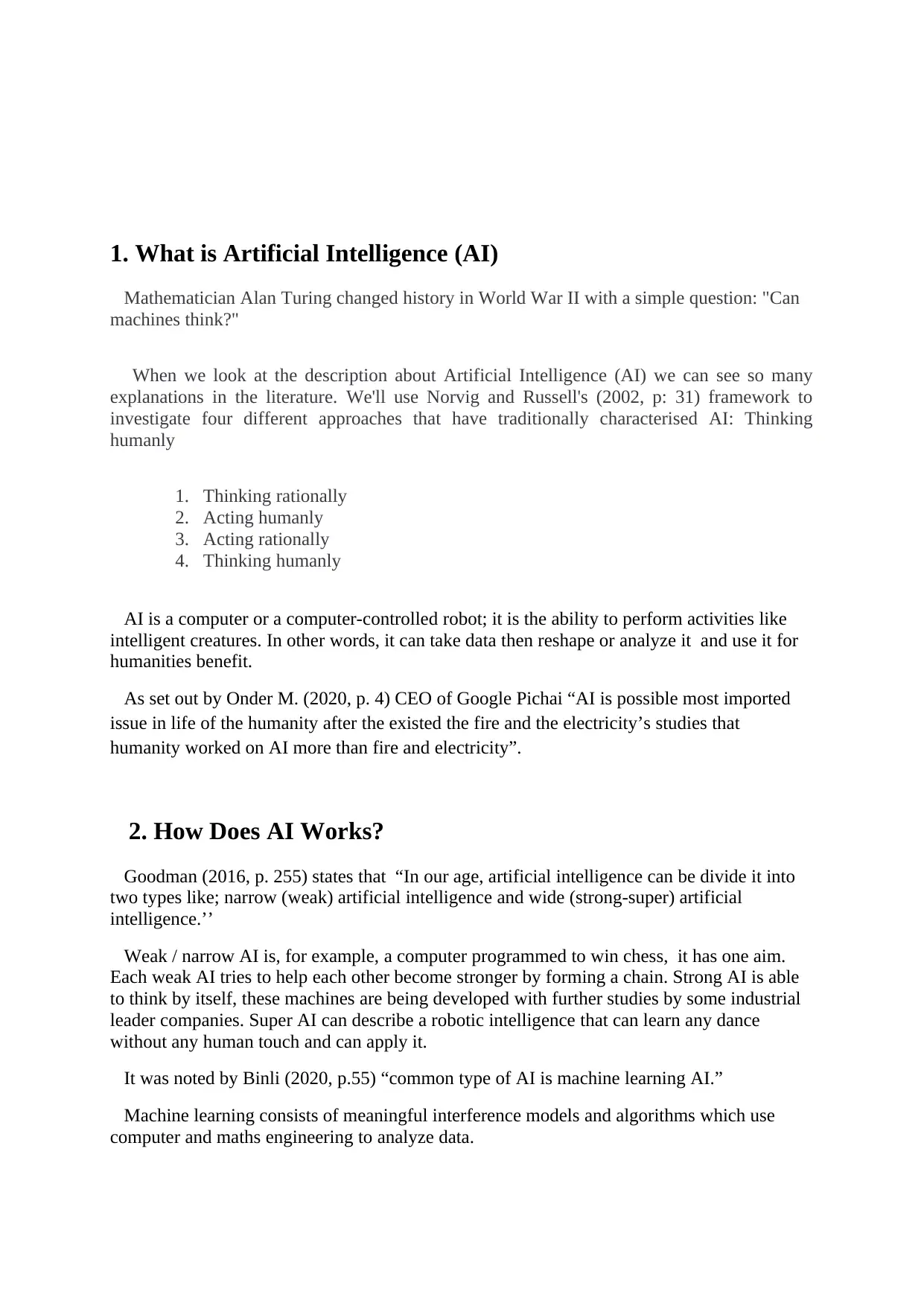
1. What is Artificial Intelligence (AI)
Mathematician Alan Turing changed history in World War II with a simple question: "Can
machines think?"
When we look at the description about Artificial Intelligence (AI) we can see so many
explanations in the literature. We'll use Norvig and Russell's (2002, p: 31) framework to
investigate four different approaches that have traditionally characterised AI: Thinking
humanly
1. Thinking rationally
2. Acting humanly
3. Acting rationally
4. Thinking humanly
AI is a computer or a computer-controlled robot; it is the ability to perform activities like
intelligent creatures. In other words, it can take data then reshape or analyze it and use it for
humanities benefit.
As set out by Onder M. (2020, p. 4) CEO of Google Pichai “AI is possible most imported
issue in life of the humanity after the existed the fire and the electricity’s studies that
humanity worked on AI more than fire and electricity”.
2. How Does AI Works?
Goodman (2016, p. 255) states that “In our age, artificial intelligence can be divide it into
two types like; narrow (weak) artificial intelligence and wide (strong-super) artificial
intelligence.’’
Weak / narrow AI is, for example, a computer programmed to win chess, it has one aim.
Each weak AI tries to help each other become stronger by forming a chain. Strong AI is able
to think by itself, these machines are being developed with further studies by some industrial
leader companies. Super AI can describe a robotic intelligence that can learn any dance
without any human touch and can apply it.
It was noted by Binli (2020, p.55) “common type of AI is machine learning AI.”
Machine learning consists of meaningful interference models and algorithms which use
computer and maths engineering to analyze data.
Mathematician Alan Turing changed history in World War II with a simple question: "Can
machines think?"
When we look at the description about Artificial Intelligence (AI) we can see so many
explanations in the literature. We'll use Norvig and Russell's (2002, p: 31) framework to
investigate four different approaches that have traditionally characterised AI: Thinking
humanly
1. Thinking rationally
2. Acting humanly
3. Acting rationally
4. Thinking humanly
AI is a computer or a computer-controlled robot; it is the ability to perform activities like
intelligent creatures. In other words, it can take data then reshape or analyze it and use it for
humanities benefit.
As set out by Onder M. (2020, p. 4) CEO of Google Pichai “AI is possible most imported
issue in life of the humanity after the existed the fire and the electricity’s studies that
humanity worked on AI more than fire and electricity”.
2. How Does AI Works?
Goodman (2016, p. 255) states that “In our age, artificial intelligence can be divide it into
two types like; narrow (weak) artificial intelligence and wide (strong-super) artificial
intelligence.’’
Weak / narrow AI is, for example, a computer programmed to win chess, it has one aim.
Each weak AI tries to help each other become stronger by forming a chain. Strong AI is able
to think by itself, these machines are being developed with further studies by some industrial
leader companies. Super AI can describe a robotic intelligence that can learn any dance
without any human touch and can apply it.
It was noted by Binli (2020, p.55) “common type of AI is machine learning AI.”
Machine learning consists of meaningful interference models and algorithms which use
computer and maths engineering to analyze data.
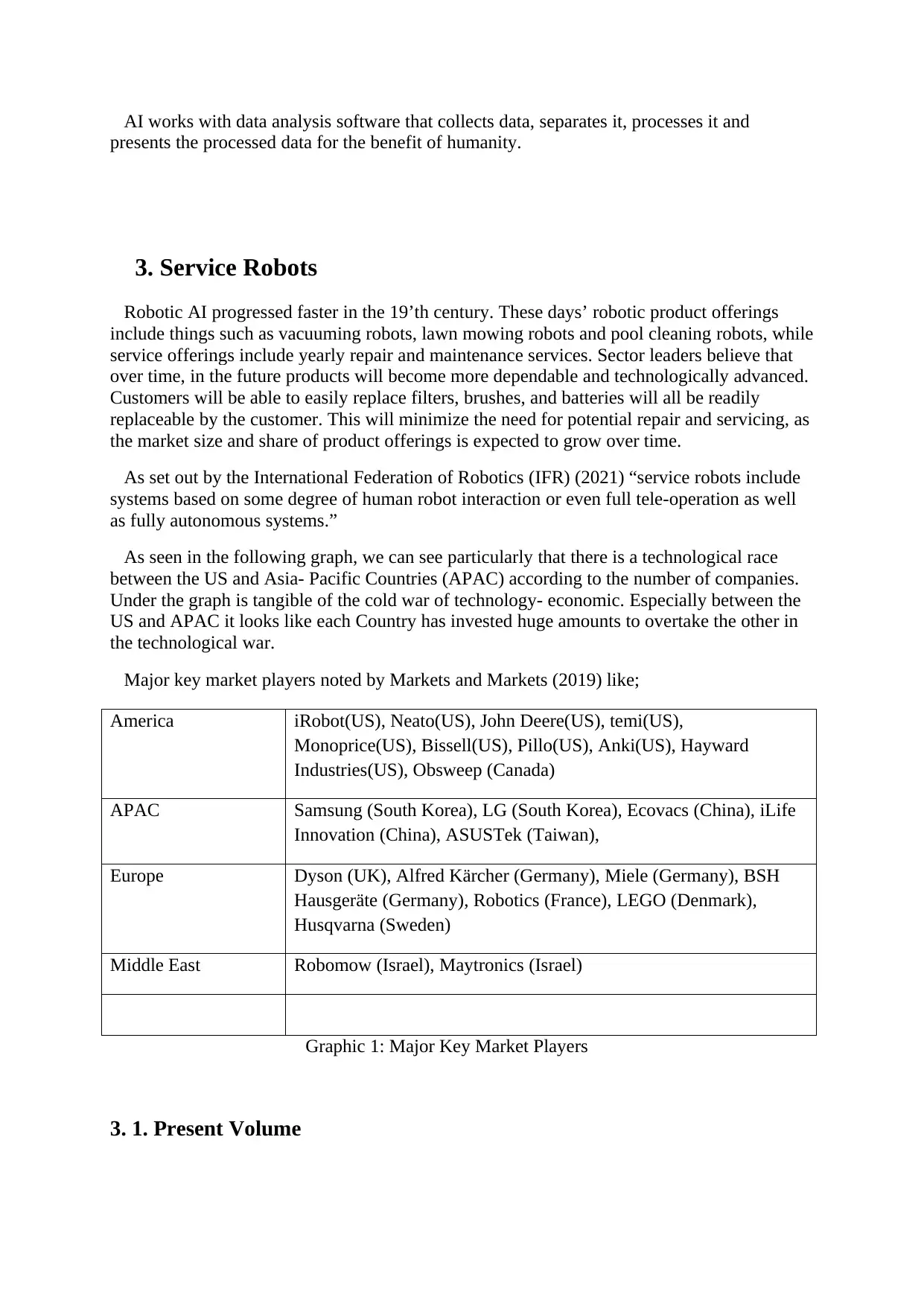
AI works with data analysis software that collects data, separates it, processes it and
presents the processed data for the benefit of humanity.
3. Service Robots
Robotic AI progressed faster in the 19’th century. These days’ robotic product offerings
include things such as vacuuming robots, lawn mowing robots and pool cleaning robots, while
service offerings include yearly repair and maintenance services. Sector leaders believe that
over time, in the future products will become more dependable and technologically advanced.
Customers will be able to easily replace filters, brushes, and batteries will all be readily
replaceable by the customer. This will minimize the need for potential repair and servicing, as
the market size and share of product offerings is expected to grow over time.
As set out by the International Federation of Robotics (IFR) (2021) “service robots include
systems based on some degree of human robot interaction or even full tele-operation as well
as fully autonomous systems.”
As seen in the following graph, we can see particularly that there is a technological race
between the US and Asia- Pacific Countries (APAC) according to the number of companies.
Under the graph is tangible of the cold war of technology- economic. Especially between the
US and APAC it looks like each Country has invested huge amounts to overtake the other in
the technological war.
Major key market players noted by Markets and Markets (2019) like;
America iRobot(US), Neato(US), John Deere(US), temi(US),
Monoprice(US), Bissell(US), Pillo(US), Anki(US), Hayward
Industries(US), Obsweep (Canada)
APAC Samsung (South Korea), LG (South Korea), Ecovacs (China), iLife
Innovation (China), ASUSTek (Taiwan),
Europe Dyson (UK), Alfred Kärcher (Germany), Miele (Germany), BSH
Hausgeräte (Germany), Robotics (France), LEGO (Denmark),
Husqvarna (Sweden)
Middle East Robomow (Israel), Maytronics (Israel)
Graphic 1: Major Key Market Players
3. 1. Present Volume
presents the processed data for the benefit of humanity.
3. Service Robots
Robotic AI progressed faster in the 19’th century. These days’ robotic product offerings
include things such as vacuuming robots, lawn mowing robots and pool cleaning robots, while
service offerings include yearly repair and maintenance services. Sector leaders believe that
over time, in the future products will become more dependable and technologically advanced.
Customers will be able to easily replace filters, brushes, and batteries will all be readily
replaceable by the customer. This will minimize the need for potential repair and servicing, as
the market size and share of product offerings is expected to grow over time.
As set out by the International Federation of Robotics (IFR) (2021) “service robots include
systems based on some degree of human robot interaction or even full tele-operation as well
as fully autonomous systems.”
As seen in the following graph, we can see particularly that there is a technological race
between the US and Asia- Pacific Countries (APAC) according to the number of companies.
Under the graph is tangible of the cold war of technology- economic. Especially between the
US and APAC it looks like each Country has invested huge amounts to overtake the other in
the technological war.
Major key market players noted by Markets and Markets (2019) like;
America iRobot(US), Neato(US), John Deere(US), temi(US),
Monoprice(US), Bissell(US), Pillo(US), Anki(US), Hayward
Industries(US), Obsweep (Canada)
APAC Samsung (South Korea), LG (South Korea), Ecovacs (China), iLife
Innovation (China), ASUSTek (Taiwan),
Europe Dyson (UK), Alfred Kärcher (Germany), Miele (Germany), BSH
Hausgeräte (Germany), Robotics (France), LEGO (Denmark),
Husqvarna (Sweden)
Middle East Robomow (Israel), Maytronics (Israel)
Graphic 1: Major Key Market Players
3. 1. Present Volume
⊘ This is a preview!⊘
Do you want full access?
Subscribe today to unlock all pages.

Trusted by 1+ million students worldwide
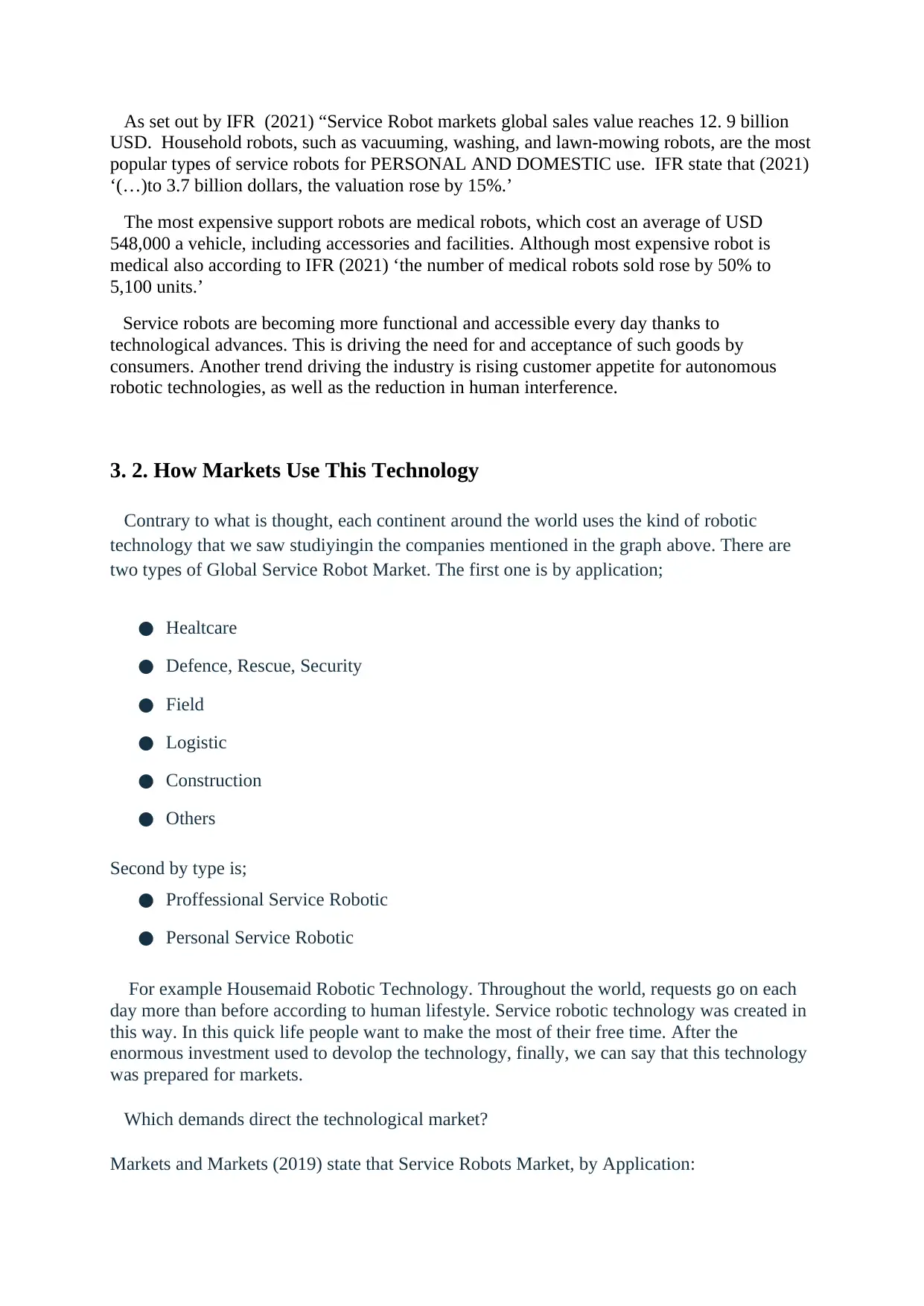
As set out by IFR (2021) “Service Robot markets global sales value reaches 12. 9 billion
USD. Household robots, such as vacuuming, washing, and lawn-mowing robots, are the most
popular types of service robots for PERSONAL AND DOMESTIC use. IFR state that (2021)
‘(…)to 3.7 billion dollars, the valuation rose by 15%.’
The most expensive support robots are medical robots, which cost an average of USD
548,000 a vehicle, including accessories and facilities. Although most expensive robot is
medical also according to IFR (2021) ‘the number of medical robots sold rose by 50% to
5,100 units.’
Service robots are becoming more functional and accessible every day thanks to
technological advances. This is driving the need for and acceptance of such goods by
consumers. Another trend driving the industry is rising customer appetite for autonomous
robotic technologies, as well as the reduction in human interference.
3. 2. How Markets Use This Technology
Contrary to what is thought, each continent around the world uses the kind of robotic
technology that we saw studiyingin the companies mentioned in the graph above. There are
two types of Global Service Robot Market. The first one is by application;
● Healtcare
● Defence, Rescue, Security
● Field
● Logistic
● Construction
● Others
Second by type is;
● Proffessional Service Robotic
● Personal Service Robotic
For example Housemaid Robotic Technology. Throughout the world, requests go on each
day more than before according to human lifestyle. Service robotic technology was created in
this way. In this quick life people want to make the most of their free time. After the
enormous investment used to devolop the technology, finally, we can say that this technology
was prepared for markets.
Which demands direct the technological market?
Markets and Markets (2019) state that Service Robots Market, by Application:
USD. Household robots, such as vacuuming, washing, and lawn-mowing robots, are the most
popular types of service robots for PERSONAL AND DOMESTIC use. IFR state that (2021)
‘(…)to 3.7 billion dollars, the valuation rose by 15%.’
The most expensive support robots are medical robots, which cost an average of USD
548,000 a vehicle, including accessories and facilities. Although most expensive robot is
medical also according to IFR (2021) ‘the number of medical robots sold rose by 50% to
5,100 units.’
Service robots are becoming more functional and accessible every day thanks to
technological advances. This is driving the need for and acceptance of such goods by
consumers. Another trend driving the industry is rising customer appetite for autonomous
robotic technologies, as well as the reduction in human interference.
3. 2. How Markets Use This Technology
Contrary to what is thought, each continent around the world uses the kind of robotic
technology that we saw studiyingin the companies mentioned in the graph above. There are
two types of Global Service Robot Market. The first one is by application;
● Healtcare
● Defence, Rescue, Security
● Field
● Logistic
● Construction
● Others
Second by type is;
● Proffessional Service Robotic
● Personal Service Robotic
For example Housemaid Robotic Technology. Throughout the world, requests go on each
day more than before according to human lifestyle. Service robotic technology was created in
this way. In this quick life people want to make the most of their free time. After the
enormous investment used to devolop the technology, finally, we can say that this technology
was prepared for markets.
Which demands direct the technological market?
Markets and Markets (2019) state that Service Robots Market, by Application:
Paraphrase This Document
Need a fresh take? Get an instant paraphrase of this document with our AI Paraphraser
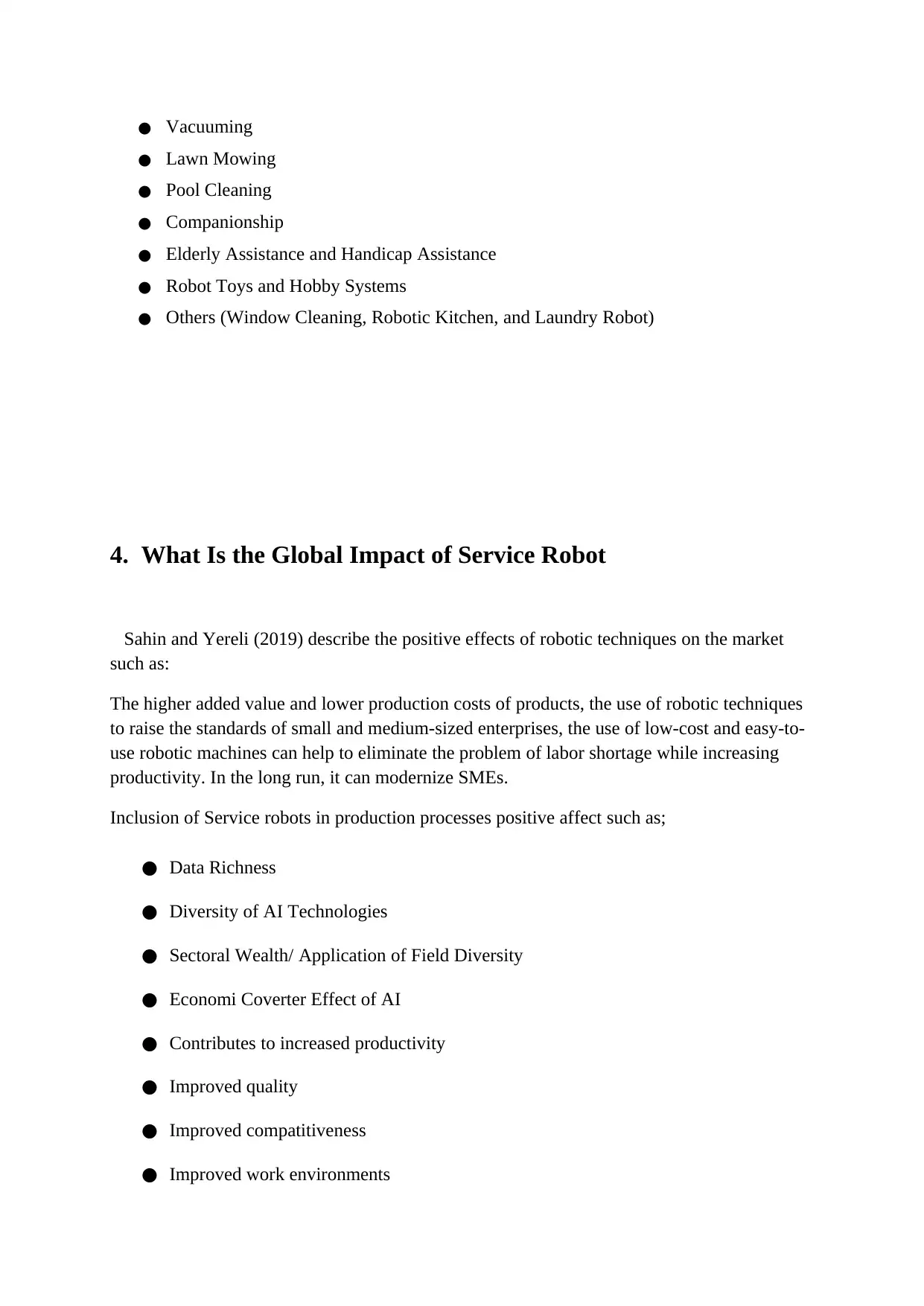
● Vacuuming
● Lawn Mowing
● Pool Cleaning
● Companionship
● Elderly Assistance and Handicap Assistance
● Robot Toys and Hobby Systems
● Others (Window Cleaning, Robotic Kitchen, and Laundry Robot)
4. What Is the Global Impact of Service Robot
Sahin and Yereli (2019) describe the positive effects of robotic techniques on the market
such as:
The higher added value and lower production costs of products, the use of robotic techniques
to raise the standards of small and medium-sized enterprises, the use of low-cost and easy-to-
use robotic machines can help to eliminate the problem of labor shortage while increasing
productivity. In the long run, it can modernize SMEs.
Inclusion of Service robots in production processes positive affect such as;
● Data Richness
● Diversity of AI Technologies
● Sectoral Wealth/ Application of Field Diversity
● Economi Coverter Effect of AI
● Contributes to increased productivity
● Improved quality
● Improved compatitiveness
● Improved work environments
● Lawn Mowing
● Pool Cleaning
● Companionship
● Elderly Assistance and Handicap Assistance
● Robot Toys and Hobby Systems
● Others (Window Cleaning, Robotic Kitchen, and Laundry Robot)
4. What Is the Global Impact of Service Robot
Sahin and Yereli (2019) describe the positive effects of robotic techniques on the market
such as:
The higher added value and lower production costs of products, the use of robotic techniques
to raise the standards of small and medium-sized enterprises, the use of low-cost and easy-to-
use robotic machines can help to eliminate the problem of labor shortage while increasing
productivity. In the long run, it can modernize SMEs.
Inclusion of Service robots in production processes positive affect such as;
● Data Richness
● Diversity of AI Technologies
● Sectoral Wealth/ Application of Field Diversity
● Economi Coverter Effect of AI
● Contributes to increased productivity
● Improved quality
● Improved compatitiveness
● Improved work environments
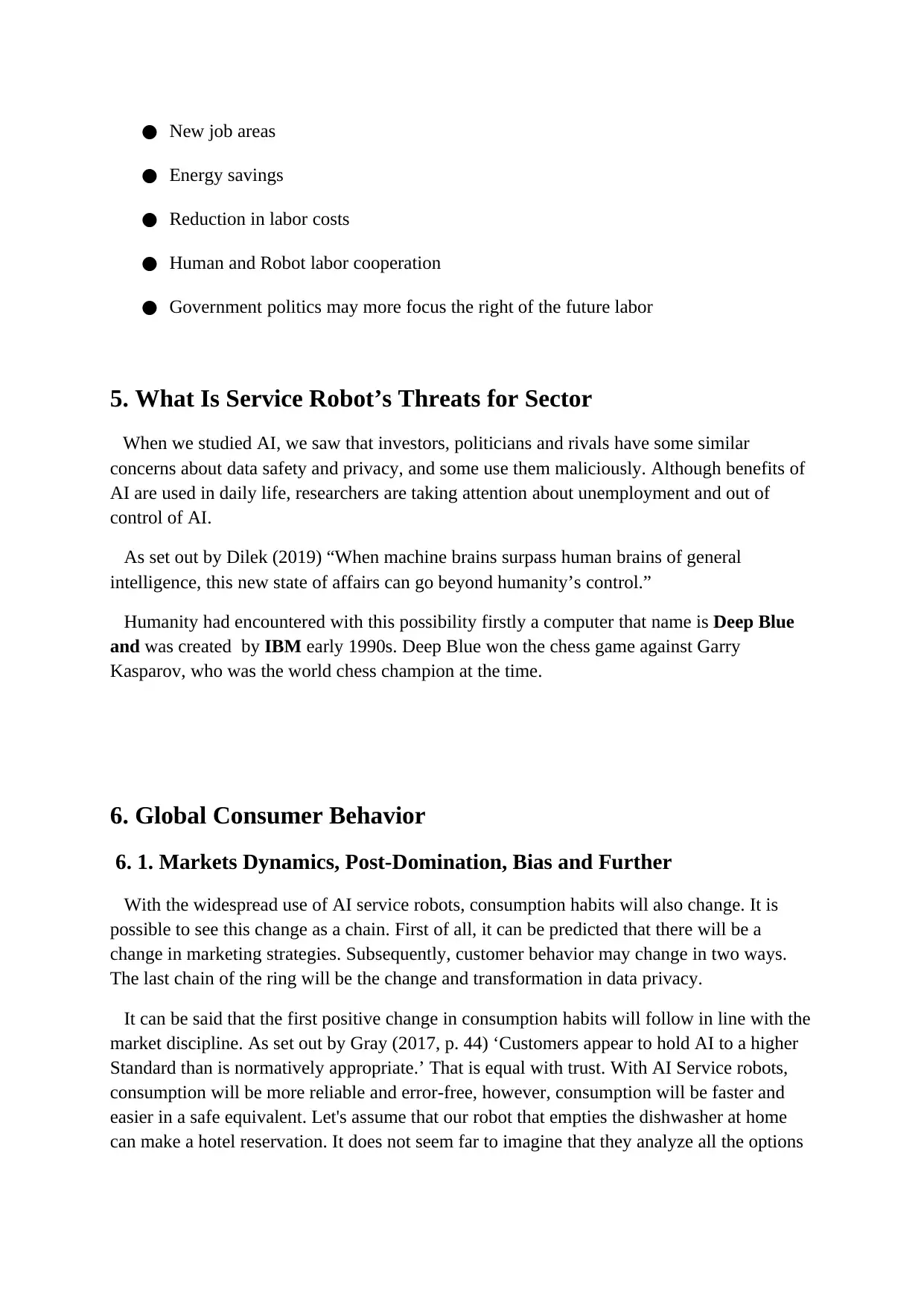
● New job areas
● Energy savings
● Reduction in labor costs
● Human and Robot labor cooperation
● Government politics may more focus the right of the future labor
5. What Is Service Robot’s Threats for Sector
When we studied AI, we saw that investors, politicians and rivals have some similar
concerns about data safety and privacy, and some use them maliciously. Although benefits of
AI are used in daily life, researchers are taking attention about unemployment and out of
control of AI.
As set out by Dilek (2019) “When machine brains surpass human brains of general
intelligence, this new state of affairs can go beyond humanity’s control.”
Humanity had encountered with this possibility firstly a computer that name is Deep Blue
and was created by IBM early 1990s. Deep Blue won the chess game against Garry
Kasparov, who was the world chess champion at the time.
6. Global Consumer Behavior
6. 1. Markets Dynamics, Post-Domination, Bias and Further
With the widespread use of AI service robots, consumption habits will also change. It is
possible to see this change as a chain. First of all, it can be predicted that there will be a
change in marketing strategies. Subsequently, customer behavior may change in two ways.
The last chain of the ring will be the change and transformation in data privacy.
It can be said that the first positive change in consumption habits will follow in line with the
market discipline. As set out by Gray (2017, p. 44) ‘Customers appear to hold AI to a higher
Standard than is normatively appropriate.’ That is equal with trust. With AI Service robots,
consumption will be more reliable and error-free, however, consumption will be faster and
easier in a safe equivalent. Let's assume that our robot that empties the dishwasher at home
can make a hotel reservation. It does not seem far to imagine that they analyze all the options
● Energy savings
● Reduction in labor costs
● Human and Robot labor cooperation
● Government politics may more focus the right of the future labor
5. What Is Service Robot’s Threats for Sector
When we studied AI, we saw that investors, politicians and rivals have some similar
concerns about data safety and privacy, and some use them maliciously. Although benefits of
AI are used in daily life, researchers are taking attention about unemployment and out of
control of AI.
As set out by Dilek (2019) “When machine brains surpass human brains of general
intelligence, this new state of affairs can go beyond humanity’s control.”
Humanity had encountered with this possibility firstly a computer that name is Deep Blue
and was created by IBM early 1990s. Deep Blue won the chess game against Garry
Kasparov, who was the world chess champion at the time.
6. Global Consumer Behavior
6. 1. Markets Dynamics, Post-Domination, Bias and Further
With the widespread use of AI service robots, consumption habits will also change. It is
possible to see this change as a chain. First of all, it can be predicted that there will be a
change in marketing strategies. Subsequently, customer behavior may change in two ways.
The last chain of the ring will be the change and transformation in data privacy.
It can be said that the first positive change in consumption habits will follow in line with the
market discipline. As set out by Gray (2017, p. 44) ‘Customers appear to hold AI to a higher
Standard than is normatively appropriate.’ That is equal with trust. With AI Service robots,
consumption will be more reliable and error-free, however, consumption will be faster and
easier in a safe equivalent. Let's assume that our robot that empties the dishwasher at home
can make a hotel reservation. It does not seem far to imagine that they analyze all the options
⊘ This is a preview!⊘
Do you want full access?
Subscribe today to unlock all pages.

Trusted by 1+ million students worldwide
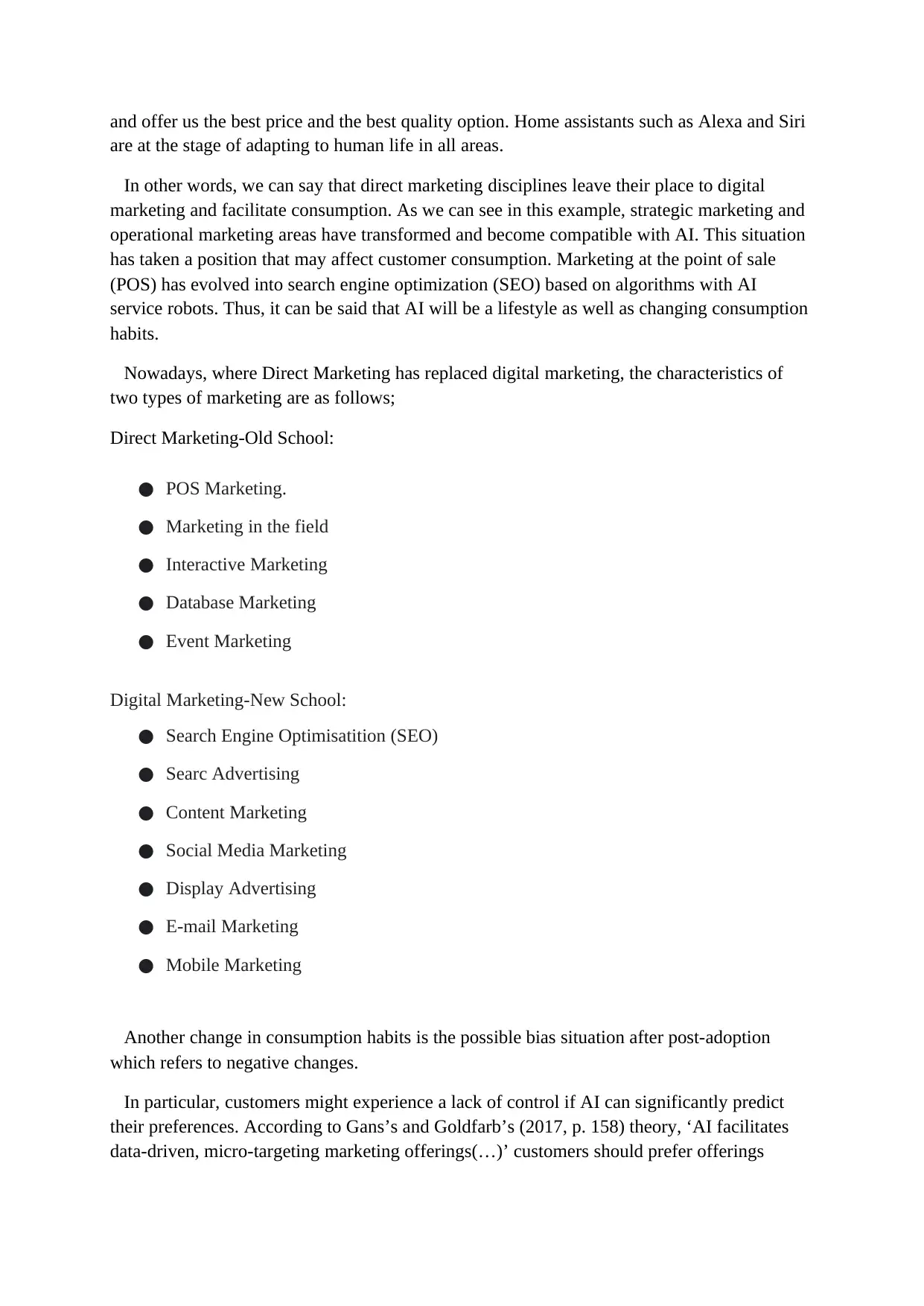
and offer us the best price and the best quality option. Home assistants such as Alexa and Siri
are at the stage of adapting to human life in all areas.
In other words, we can say that direct marketing disciplines leave their place to digital
marketing and facilitate consumption. As we can see in this example, strategic marketing and
operational marketing areas have transformed and become compatible with AI. This situation
has taken a position that may affect customer consumption. Marketing at the point of sale
(POS) has evolved into search engine optimization (SEO) based on algorithms with AI
service robots. Thus, it can be said that AI will be a lifestyle as well as changing consumption
habits.
Nowadays, where Direct Marketing has replaced digital marketing, the characteristics of
two types of marketing are as follows;
Direct Marketing-Old School:
● POS Marketing.
● Marketing in the field
● Interactive Marketing
● Database Marketing
● Event Marketing
Digital Marketing-New School:
● Search Engine Optimisatition (SEO)
● Searc Advertising
● Content Marketing
● Social Media Marketing
● Display Advertising
● E-mail Marketing
● Mobile Marketing
Another change in consumption habits is the possible bias situation after post-adoption
which refers to negative changes.
In particular, customers might experience a lack of control if AI can significantly predict
their preferences. According to Gans’s and Goldfarb’s (2017, p. 158) theory, ‘AI facilitates
data-driven, micro-targeting marketing offerings(…)’ customers should prefer offerings
are at the stage of adapting to human life in all areas.
In other words, we can say that direct marketing disciplines leave their place to digital
marketing and facilitate consumption. As we can see in this example, strategic marketing and
operational marketing areas have transformed and become compatible with AI. This situation
has taken a position that may affect customer consumption. Marketing at the point of sale
(POS) has evolved into search engine optimization (SEO) based on algorithms with AI
service robots. Thus, it can be said that AI will be a lifestyle as well as changing consumption
habits.
Nowadays, where Direct Marketing has replaced digital marketing, the characteristics of
two types of marketing are as follows;
Direct Marketing-Old School:
● POS Marketing.
● Marketing in the field
● Interactive Marketing
● Database Marketing
● Event Marketing
Digital Marketing-New School:
● Search Engine Optimisatition (SEO)
● Searc Advertising
● Content Marketing
● Social Media Marketing
● Display Advertising
● E-mail Marketing
● Mobile Marketing
Another change in consumption habits is the possible bias situation after post-adoption
which refers to negative changes.
In particular, customers might experience a lack of control if AI can significantly predict
their preferences. According to Gans’s and Goldfarb’s (2017, p. 158) theory, ‘AI facilitates
data-driven, micro-targeting marketing offerings(…)’ customers should prefer offerings
Paraphrase This Document
Need a fresh take? Get an instant paraphrase of this document with our AI Paraphraser
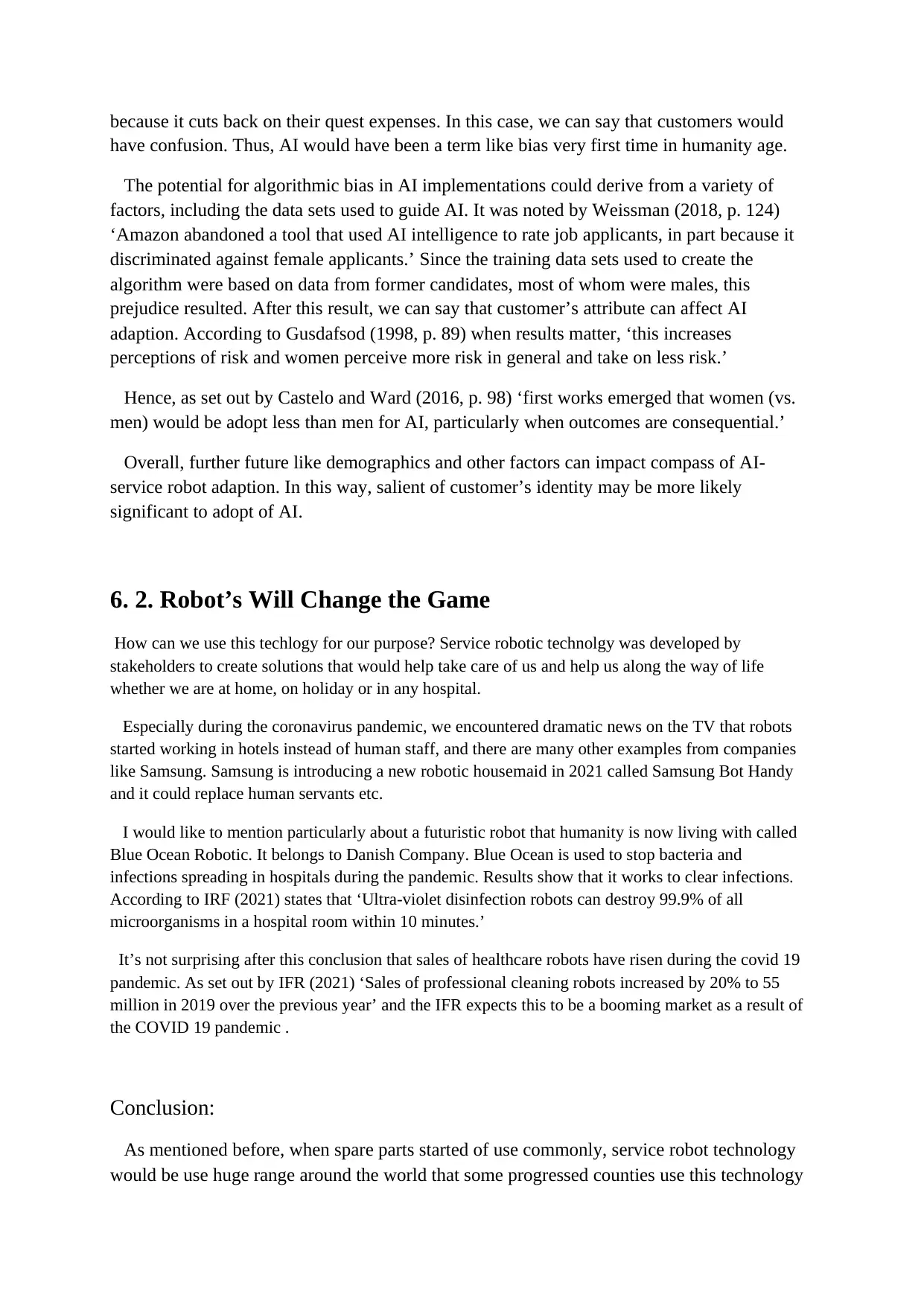
because it cuts back on their quest expenses. In this case, we can say that customers would
have confusion. Thus, AI would have been a term like bias very first time in humanity age.
The potential for algorithmic bias in AI implementations could derive from a variety of
factors, including the data sets used to guide AI. It was noted by Weissman (2018, p. 124)
‘Amazon abandoned a tool that used AI intelligence to rate job applicants, in part because it
discriminated against female applicants.’ Since the training data sets used to create the
algorithm were based on data from former candidates, most of whom were males, this
prejudice resulted. After this result, we can say that customer’s attribute can affect AI
adaption. According to Gusdafsod (1998, p. 89) when results matter, ‘this increases
perceptions of risk and women perceive more risk in general and take on less risk.’
Hence, as set out by Castelo and Ward (2016, p. 98) ‘first works emerged that women (vs.
men) would be adopt less than men for AI, particularly when outcomes are consequential.’
Overall, further future like demographics and other factors can impact compass of AI-
service robot adaption. In this way, salient of customer’s identity may be more likely
significant to adopt of AI.
6. 2. Robot’s Will Change the Game
How can we use this techlogy for our purpose? Service robotic technolgy was developed by
stakeholders to create solutions that would help take care of us and help us along the way of life
whether we are at home, on holiday or in any hospital.
Especially during the coronavirus pandemic, we encountered dramatic news on the TV that robots
started working in hotels instead of human staff, and there are many other examples from companies
like Samsung. Samsung is introducing a new robotic housemaid in 2021 called Samsung Bot Handy
and it could replace human servants etc.
I would like to mention particularly about a futuristic robot that humanity is now living with called
Blue Ocean Robotic. It belongs to Danish Company. Blue Ocean is used to stop bacteria and
infections spreading in hospitals during the pandemic. Results show that it works to clear infections.
According to IRF (2021) states that ‘Ultra-violet disinfection robots can destroy 99.9% of all
microorganisms in a hospital room within 10 minutes.’
It’s not surprising after this conclusion that sales of healthcare robots have risen during the covid 19
pandemic. As set out by IFR (2021) ‘Sales of professional cleaning robots increased by 20% to 55
million in 2019 over the previous year’ and the IFR expects this to be a booming market as a result of
the COVID 19 pandemic .
Conclusion:
As mentioned before, when spare parts started of use commonly, service robot technology
would be use huge range around the world that some progressed counties use this technology
have confusion. Thus, AI would have been a term like bias very first time in humanity age.
The potential for algorithmic bias in AI implementations could derive from a variety of
factors, including the data sets used to guide AI. It was noted by Weissman (2018, p. 124)
‘Amazon abandoned a tool that used AI intelligence to rate job applicants, in part because it
discriminated against female applicants.’ Since the training data sets used to create the
algorithm were based on data from former candidates, most of whom were males, this
prejudice resulted. After this result, we can say that customer’s attribute can affect AI
adaption. According to Gusdafsod (1998, p. 89) when results matter, ‘this increases
perceptions of risk and women perceive more risk in general and take on less risk.’
Hence, as set out by Castelo and Ward (2016, p. 98) ‘first works emerged that women (vs.
men) would be adopt less than men for AI, particularly when outcomes are consequential.’
Overall, further future like demographics and other factors can impact compass of AI-
service robot adaption. In this way, salient of customer’s identity may be more likely
significant to adopt of AI.
6. 2. Robot’s Will Change the Game
How can we use this techlogy for our purpose? Service robotic technolgy was developed by
stakeholders to create solutions that would help take care of us and help us along the way of life
whether we are at home, on holiday or in any hospital.
Especially during the coronavirus pandemic, we encountered dramatic news on the TV that robots
started working in hotels instead of human staff, and there are many other examples from companies
like Samsung. Samsung is introducing a new robotic housemaid in 2021 called Samsung Bot Handy
and it could replace human servants etc.
I would like to mention particularly about a futuristic robot that humanity is now living with called
Blue Ocean Robotic. It belongs to Danish Company. Blue Ocean is used to stop bacteria and
infections spreading in hospitals during the pandemic. Results show that it works to clear infections.
According to IRF (2021) states that ‘Ultra-violet disinfection robots can destroy 99.9% of all
microorganisms in a hospital room within 10 minutes.’
It’s not surprising after this conclusion that sales of healthcare robots have risen during the covid 19
pandemic. As set out by IFR (2021) ‘Sales of professional cleaning robots increased by 20% to 55
million in 2019 over the previous year’ and the IFR expects this to be a booming market as a result of
the COVID 19 pandemic .
Conclusion:
As mentioned before, when spare parts started of use commonly, service robot technology
would be use huge range around the world that some progressed counties use this technology
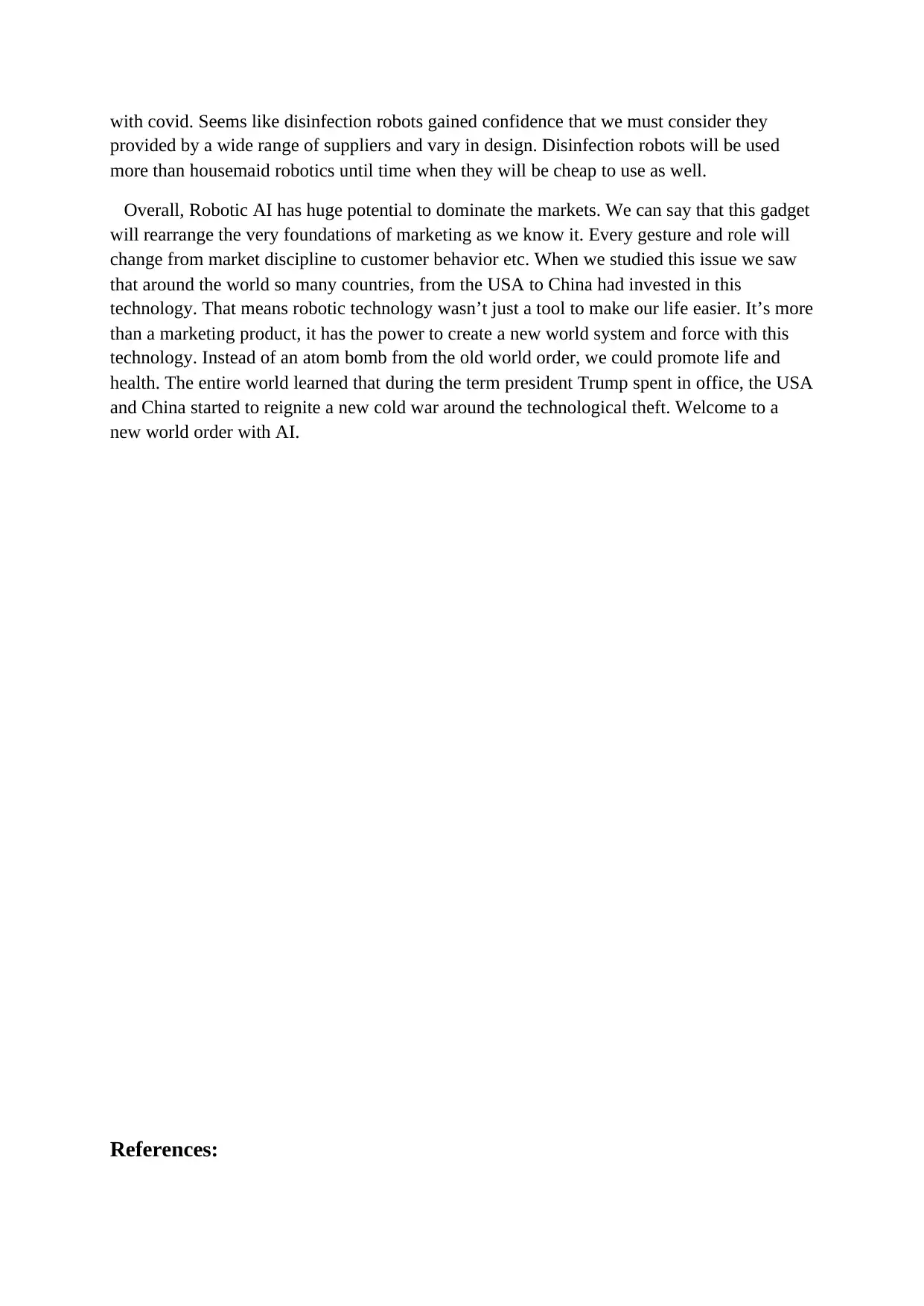
with covid. Seems like disinfection robots gained confidence that we must consider they
provided by a wide range of suppliers and vary in design. Disinfection robots will be used
more than housemaid robotics until time when they will be cheap to use as well.
Overall, Robotic AI has huge potential to dominate the markets. We can say that this gadget
will rearrange the very foundations of marketing as we know it. Every gesture and role will
change from market discipline to customer behavior etc. When we studied this issue we saw
that around the world so many countries, from the USA to China had invested in this
technology. That means robotic technology wasn’t just a tool to make our life easier. It’s more
than a marketing product, it has the power to create a new world system and force with this
technology. Instead of an atom bomb from the old world order, we could promote life and
health. The entire world learned that during the term president Trump spent in office, the USA
and China started to reignite a new cold war around the technological theft. Welcome to a
new world order with AI.
References:
provided by a wide range of suppliers and vary in design. Disinfection robots will be used
more than housemaid robotics until time when they will be cheap to use as well.
Overall, Robotic AI has huge potential to dominate the markets. We can say that this gadget
will rearrange the very foundations of marketing as we know it. Every gesture and role will
change from market discipline to customer behavior etc. When we studied this issue we saw
that around the world so many countries, from the USA to China had invested in this
technology. That means robotic technology wasn’t just a tool to make our life easier. It’s more
than a marketing product, it has the power to create a new world system and force with this
technology. Instead of an atom bomb from the old world order, we could promote life and
health. The entire world learned that during the term president Trump spent in office, the USA
and China started to reignite a new cold war around the technological theft. Welcome to a
new world order with AI.
References:
⊘ This is a preview!⊘
Do you want full access?
Subscribe today to unlock all pages.

Trusted by 1+ million students worldwide
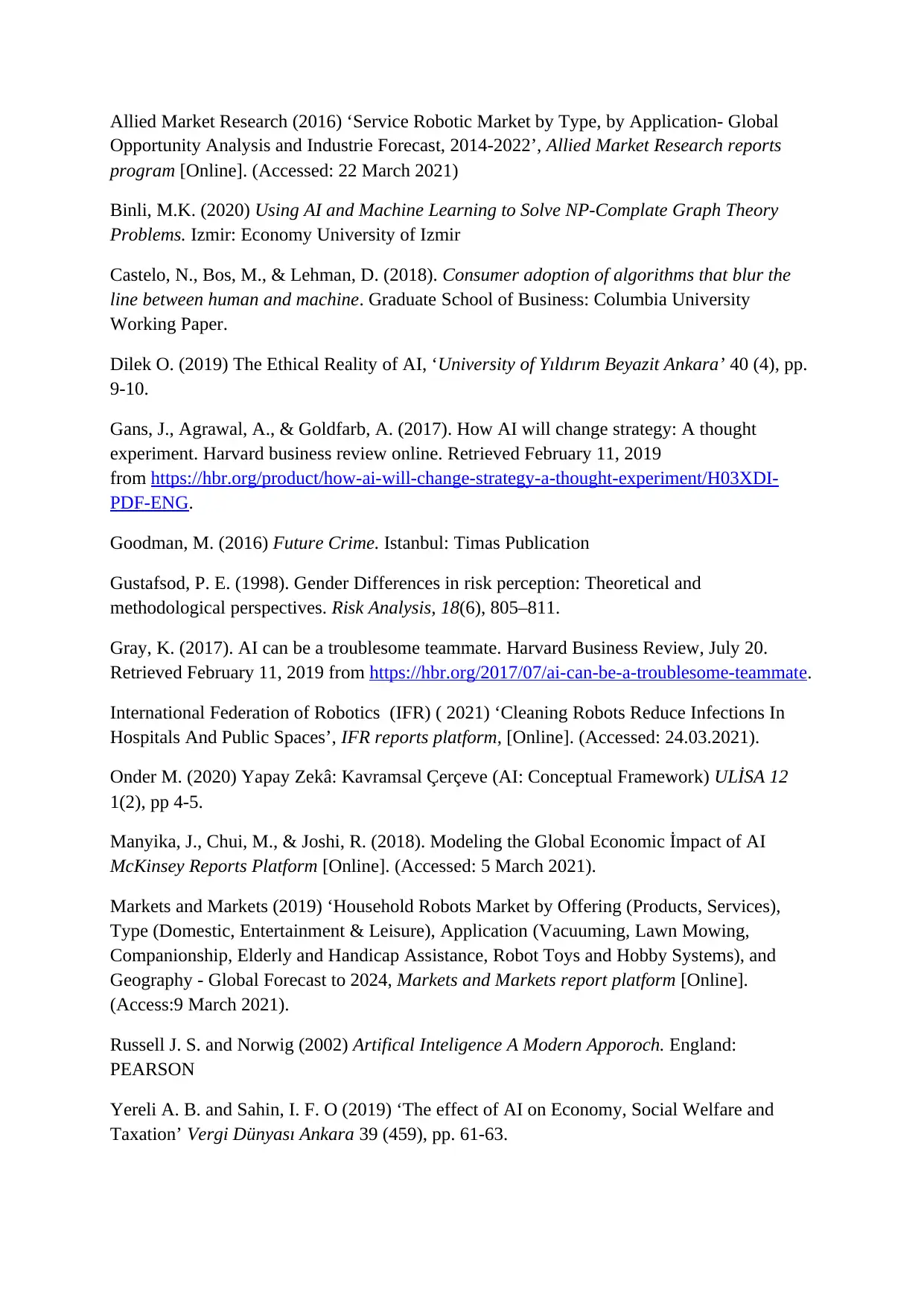
Allied Market Research (2016) ‘Service Robotic Market by Type, by Application- Global
Opportunity Analysis and Industrie Forecast, 2014-2022’, Allied Market Research reports
program [Online]. (Accessed: 22 March 2021)
Binli, M.K. (2020) Using AI and Machine Learning to Solve NP-Complate Graph Theory
Problems. Izmir: Economy University of Izmir
Castelo, N., Bos, M., & Lehman, D. (2018). Consumer adoption of algorithms that blur the
line between human and machine. Graduate School of Business: Columbia University
Working Paper.
Dilek O. (2019) The Ethical Reality of AI, ‘University of Yıldırım Beyazit Ankara’ 40 (4), pp.
9-10.
Gans, J., Agrawal, A., & Goldfarb, A. (2017). How AI will change strategy: A thought
experiment. Harvard business review online. Retrieved February 11, 2019
from https://hbr.org/product/how-ai-will-change-strategy-a-thought-experiment/H03XDI-
PDF-ENG.
Goodman, M. (2016) Future Crime. Istanbul: Timas Publication
Gustafsod, P. E. (1998). Gender Differences in risk perception: Theoretical and
methodological perspectives. Risk Analysis, 18(6), 805–811.
Gray, K. (2017). AI can be a troublesome teammate. Harvard Business Review, July 20.
Retrieved February 11, 2019 from https://hbr.org/2017/07/ai-can-be-a-troublesome-teammate.
International Federation of Robotics (IFR) ( 2021) ‘Cleaning Robots Reduce Infections In
Hospitals And Public Spaces’, IFR reports platform, [Online]. (Accessed: 24.03.2021).
Onder M. (2020) Yapay Zekâ: Kavramsal Çerçeve (AI: Conceptual Framework) ULİSA 12
1(2), pp 4-5.
Manyika, J., Chui, M., & Joshi, R. (2018). Modeling the Global Economic İmpact of AI
McKinsey Reports Platform [Online]. (Accessed: 5 March 2021).
Markets and Markets (2019) ‘Household Robots Market by Offering (Products, Services),
Type (Domestic, Entertainment & Leisure), Application (Vacuuming, Lawn Mowing,
Companionship, Elderly and Handicap Assistance, Robot Toys and Hobby Systems), and
Geography - Global Forecast to 2024, Markets and Markets report platform [Online].
(Access:9 March 2021).
Russell J. S. and Norwig (2002) Artifical Inteligence A Modern Apporoch. England:
PEARSON
Yereli A. B. and Sahin, I. F. O (2019) ‘The effect of AI on Economy, Social Welfare and
Taxation’ Vergi Dünyası Ankara 39 (459), pp. 61-63.
Opportunity Analysis and Industrie Forecast, 2014-2022’, Allied Market Research reports
program [Online]. (Accessed: 22 March 2021)
Binli, M.K. (2020) Using AI and Machine Learning to Solve NP-Complate Graph Theory
Problems. Izmir: Economy University of Izmir
Castelo, N., Bos, M., & Lehman, D. (2018). Consumer adoption of algorithms that blur the
line between human and machine. Graduate School of Business: Columbia University
Working Paper.
Dilek O. (2019) The Ethical Reality of AI, ‘University of Yıldırım Beyazit Ankara’ 40 (4), pp.
9-10.
Gans, J., Agrawal, A., & Goldfarb, A. (2017). How AI will change strategy: A thought
experiment. Harvard business review online. Retrieved February 11, 2019
from https://hbr.org/product/how-ai-will-change-strategy-a-thought-experiment/H03XDI-
PDF-ENG.
Goodman, M. (2016) Future Crime. Istanbul: Timas Publication
Gustafsod, P. E. (1998). Gender Differences in risk perception: Theoretical and
methodological perspectives. Risk Analysis, 18(6), 805–811.
Gray, K. (2017). AI can be a troublesome teammate. Harvard Business Review, July 20.
Retrieved February 11, 2019 from https://hbr.org/2017/07/ai-can-be-a-troublesome-teammate.
International Federation of Robotics (IFR) ( 2021) ‘Cleaning Robots Reduce Infections In
Hospitals And Public Spaces’, IFR reports platform, [Online]. (Accessed: 24.03.2021).
Onder M. (2020) Yapay Zekâ: Kavramsal Çerçeve (AI: Conceptual Framework) ULİSA 12
1(2), pp 4-5.
Manyika, J., Chui, M., & Joshi, R. (2018). Modeling the Global Economic İmpact of AI
McKinsey Reports Platform [Online]. (Accessed: 5 March 2021).
Markets and Markets (2019) ‘Household Robots Market by Offering (Products, Services),
Type (Domestic, Entertainment & Leisure), Application (Vacuuming, Lawn Mowing,
Companionship, Elderly and Handicap Assistance, Robot Toys and Hobby Systems), and
Geography - Global Forecast to 2024, Markets and Markets report platform [Online].
(Access:9 March 2021).
Russell J. S. and Norwig (2002) Artifical Inteligence A Modern Apporoch. England:
PEARSON
Yereli A. B. and Sahin, I. F. O (2019) ‘The effect of AI on Economy, Social Welfare and
Taxation’ Vergi Dünyası Ankara 39 (459), pp. 61-63.
1 out of 10
Related Documents
Your All-in-One AI-Powered Toolkit for Academic Success.
+13062052269
info@desklib.com
Available 24*7 on WhatsApp / Email
![[object Object]](/_next/static/media/star-bottom.7253800d.svg)
Unlock your academic potential
Copyright © 2020–2025 A2Z Services. All Rights Reserved. Developed and managed by ZUCOL.





